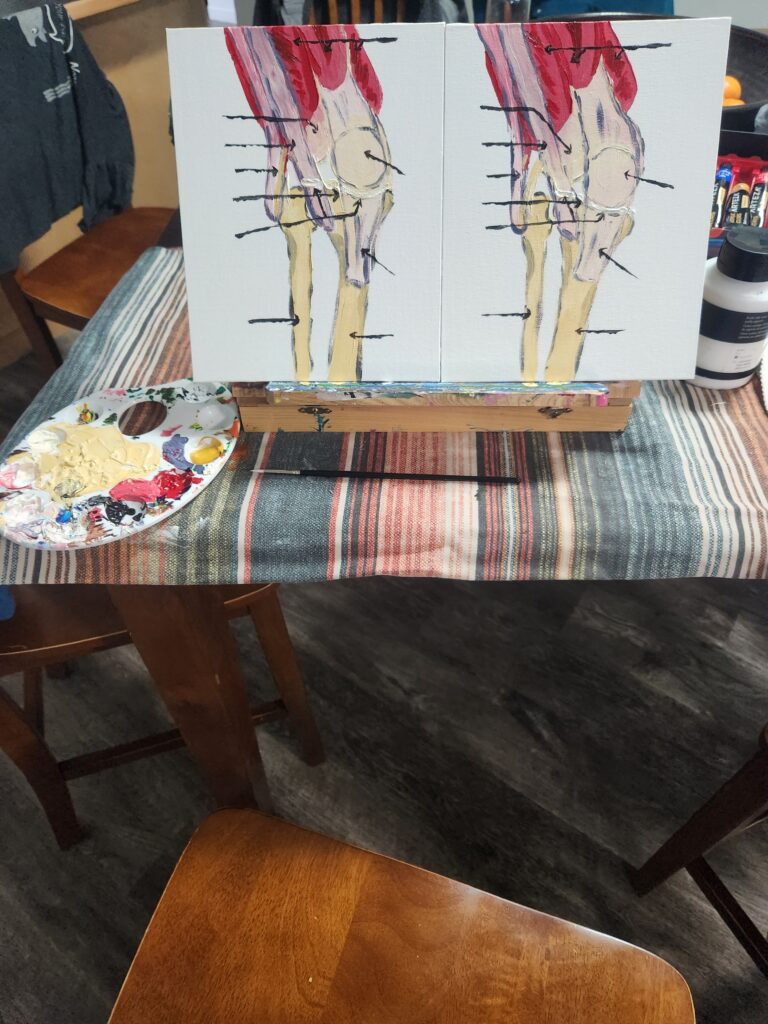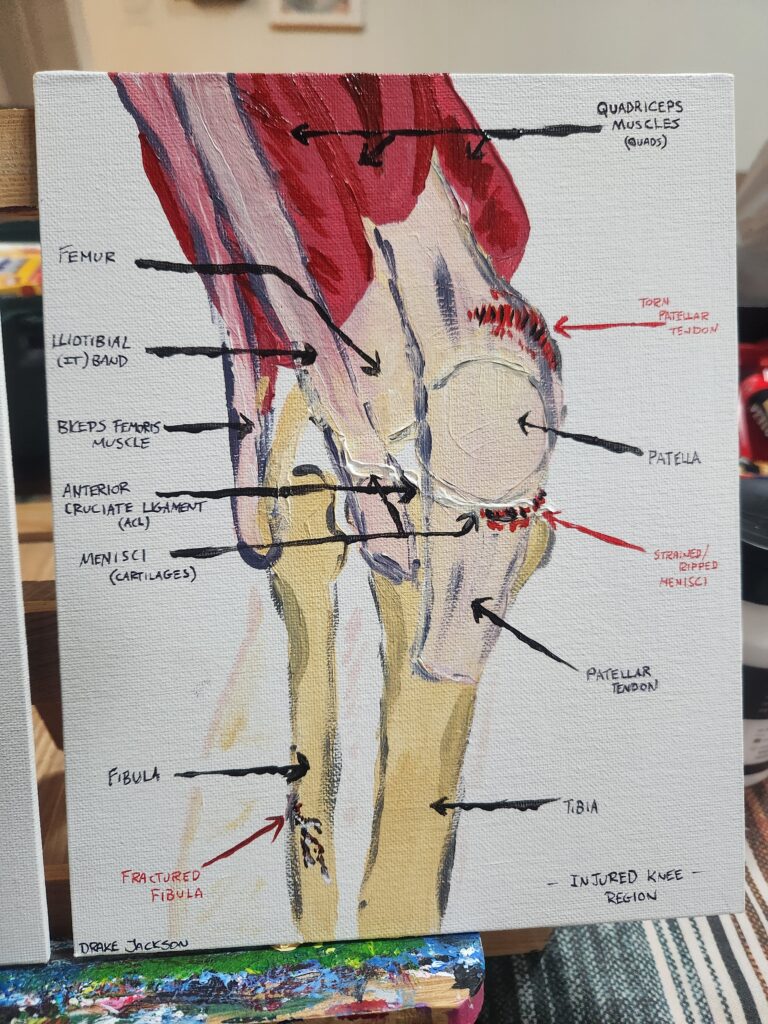For my STEAM project I wanted to show how easily and commonly parts of the knee area of our legs can be damaged. This was partially due to my own experiences with it, and it seemed like a good example to use. So in my STEAM project I only painted and identified injuries I am familiar with, having had them or seen them in a friend. Leg injuries are very common in martial arts, so I see a lot of them. In Taekwondo, My practiced sport, Taking care of your legs is very important. So I am showing three injury locations with the problems and causes.
Throughout our legs, and especially around their most important joint,The knee, there are a lot of injuries to be had. I at first wanted to just focus on the ligaments and tendons and their damage, but bone injuries are also A part of the topic. The Patella, also known as your kneecap, Is a very important part of that joint. The Patella Protects the knee joints, acts as a support for multiple tendons, and helps your quads move your leg. But despite its protective value, it itself is not immune to damage. Especially in the Patellar tendon, which keeps it in place and connects it to many other parts. The patellar tendon is not easy to damage, due to its elasticity and high strength, but in elderly people, and very active people, this is a commonly seen point of damage. What makes it common In elderly people is the fact that as one ages, these tendons tend to weaken. In the case of highly active people, it is excessive force that is most often to blame. Though very durable, if put under too much strain very suddenly, Such as a landing from a large jump, It can tear, or in the worst of cases, break completely. In either case, surgical treatment is almost always necessary due to the body’s lack of ability to repair it. It leaves the leg without proper ability to function, as A large point of support is now gone. The quads lose the ability to properly support the tibia, and therefore walking with this injury is difficult. And though it can be repaired, it will never have its original durability, and can be vulnerable to a re rupture.
The second injury I have in my STEAM project is a torn meniscus. The meniscus is a small section of cartilage that acts as a cushion in between The knee joint. Once again, there are two common causes for these tears. Age, and high activity. Due to its purpose as a cushion that stops the bones from grinding, it is no surprise that it wears down over a long period of time. In elderly people it is no surprise to see this injury due to the lifetime of wear on it. With athletes,It is commonly seen in cases of sudden Pivots and motions that cause strain. It is also a common martial arts injury in sports such as Taekwondo that rely on high pivoting kicks that put strain on the stationary leg. A torn meniscus is an injury that can cause locking of the knee joint, and large amounts of grinding in the bone, as well as an amount of damage to its surrounding muscles. This injury either can, or cannot heal on its own depending on depth. Only the outer third of the meniscus has blood vessels and a way to repair itself, if the injury goes deeper than that, surgery is required. In the case of a naturally healable tear, it is common to see the meniscus back in working condition in as little as 6 weeks. In the case where surgical care is needed, it may never be fully functional again.
The final injury seen in my project is one that can happen on any bone in the body, but is most common in our ribs and legs. A fracture. In this case it is a fibula fracture. The treatment and issues with a fibula fracture is entirely dependent on whether or not the fracture is in the top or bottom half of the fibula, I have seen both, but only have had an upper half fracture, which is lucky. The Fibula is generally a very safe bone. Most impacts you will see in life come from the front of your legs, and generally a hit from the back is cushioned enough to be fine as well. The easiest way to get a fibula fracture is an injury from the side of your leg.They can also be caused by an injury from your ankle, such as a very badly rolled ankle. A fractured fibula can be treated in several ways depending on intensity and location. A small, ankle based fracture can often be treated with a cast and time for the body to heal it. In more serious cases, Plates and ankle screws may be necessary, which can permanently inhibit mobility in that joint. The fibula being fractured is not as painful, or as problematic as a fractured tibia, and your fibulas only bear about one sixth of your body weight, but they can still cause greatly hindered mobility and pain during the duration of the injury. In the case of A high fibular fracture, time is often the best treatment. As in a case of a higher fracture, the body is remarkably efficient at repairing it.
Leg injuries are a large part of my competitive career, and because of this I have to keep track of things like where not to let myself get hit, and how to move to put the least strain on vulnerable parts. Studying the leg structure and bone structure in this class has actually been very beneficial for that purpose, as it has allowed me to see a lot of the problem areas a lot closer.
The national library of medicine was my key resource.
I got my surgical information here
I only used this site as a sort of double check on information I was not sure about. As it explained it very simply.





In this STEAM project, Drake draws on the personal experience practicing Taekwondo to explore the prevalence and impact of knee injuries. The project identifies and describes in great detail three common knee injury sites, highlighting their problems and causes, intending to increase awareness of the vulnerability of the knee region and emphasize the importance of knee health in activities.
The first area of concern is the patella, which is considered a vital component of the knee joint. Although the patellar tendon is known for its elasticity and strength, it is vulnerable to injury in seniors due to weakened tendons and in active individuals due to excessive exertion. This injury can severely impair leg function and may even lead to fracture again.
The second injury studied was a tear of the meniscus, a crucial cushion that helps prevent bone grinding within the knee joint. Age and high activity levels are thought to be common causes of meniscus tears. Depending on the depth of the tear, it may heal on its own; if not, surgery will be necessary. This injury often results in the locking of the knee joint and grinding of the bone, with long-term effects on mobility.
The final injury is a fibula fracture, which can occur in any bone but is most common in the ribs and legs. An impact to the side of the leg or severe ankle rotation can lead to a fibula fracture. Treatment options vary according to location and severity, with minor fractures healing over time, while more severe cases may require plates and ankle screws. Higher fractures may self-repair over time.